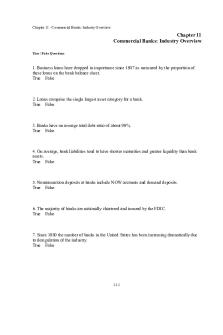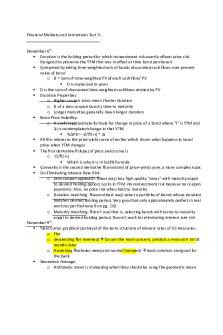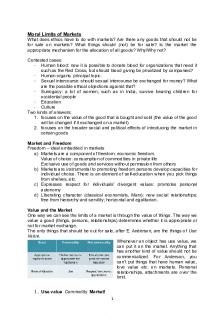Contestable markets econhelp PDF

| Title | Contestable markets econhelp |
|---|---|
| Course | Eco |
| Institution | North South University |
| Pages | 5 |
| File Size | 234.9 KB |
| File Type | |
| Total Downloads | 16 |
| Total Views | 126 |
Summary
economics...
Description
Contestable markets
A contestable market occurs when there is freedom of entry and exit into the market. In a contestable market, there will be low sunk costs. (Costs which can’t be recovered when leaving the market) Due to freedom of entry and exit – existing firms always face the threat of new firms entering the market. This threat of entry is sufficient to keep prices close to a competitive equilibrium and profits low – otherwise, new firms enter. In a contestable market, it is not the number of firms that is important, but the ease by which new firms can enter the market. Diagram of contestable market
If the market was a monopoly with high barriers to entry, the firm would maximise profits at P1, Q1 (point A) If the market became perfectly contestable – with freedom of entry and exit, then the existing firm would have an incentive to cut prices to P2 (point B) – Otherwise, new firms would enter the market until normal profits are made. Therefore, contestable markets will have lower profits than monopoly. Contestable markets and the public interest Contestable markets can bring the benefits of competitive markets such as:
Lower prices (allocative efficiency) Increased incentives for firms to cut costs (x-efficiency) Increased incentives for firms to respond to consumer preferences (allocative efficiency) However, there could also be significant economies of scale because the theory of contestable markets doesn’t require there to be 1000s of firms
Therefore policymakers should not just look at the degree of concentration, but also the degree of contestability and how easy it is to enter the market. Regulators in the privatised industries have often focused on removing barriers to entry, rather than breaking up big firms. Factors which determine the contestability of a market
When considering the contestability of markets it is important to consider the different barriers to entry a new firm may face 1.
Sunk Costs If sunk costs are high this makes it difficult for new firms to enter and leave the market. Therefore it will be less contestable. For example, if a new firm had to purchase raw materials, that it wouldn’t be able to resell on leaving the market, this may act as a deterrent.
2.
Levels of advertising and brand loyalty. If an established firm has significant brand loyalty such as Coca-Cola, then it will be difficult for a new firm to enter the market. This is because they would have to spend a lot of money on advertising which is a sunk cost. Even if they spend money on advertising it may not be sufficient to change customer loyalty to very strong brands. It depends on the industry, customer loyalty would be fairly low for a product like petrol because it is quite homogenous. But, for soft drinks, people have greater attachment to their ‘brand’ 3. Vertical Integration If a firm does not have access to the supply of a good then the market will be less contestable. E.g. Oil firms could restrict the supply of petrol to petrol stations, making it difficult for new firms to enter. If you wish to sell electricity to domestic customers, a big issue is whether you can gain access to the electricity grid. The national electric grid is a natural monopoly, but government regulation can make sure firms have a fair access to the grid. Giving access to different stages of production can make the market more contestable. (How vertical barriers can restrict competition) 4. Access to technology and skilled labour For some industries like car production it is difficult for new firms to have the right technology. Nuclear power may require skilled labour that is difficult to get. This makes the market less contestable. If you wished to compete with Google, you may find it hard to employ the best software engineers because Google pays its employees a very good wage and is seen as an attractive company to work for. As well as looking at barriers to entry, there are other factors that might indicate the competitiveness of a market.
The level of profit. If the market is highly profitable, this suggests the market is less contestable. In theory, if firms are making supernormal profit, it would attract new firms into the market. The persistence of supernormal profits suggests that hit and run competition is not possible and there are barriers to entry. The number of firms. A contestable market could have a low number of firms – as long as there is the threat and possibility of new firms entering. However, if there are only a few firms and it has been many years since any new firms have entered, then it is likely to be less contestable. If there are recent examples of firms entering the market, then it is likely to be more contestable. It is important to remember that contestability is not a clear cut issue, there are degrees of contestability, some markets having more capacity for new firms to enter. In practise, few industries are perfectly contestable. Example – UK Banking industry
1. 2.
There are high sunk costs in getting a network of banks set up around the country.. Brand loyalty to existing banks is high. Customers are not so willing to switch. Therefore a new firm may have to spend a lot on advertising to attract new customers, which is a sunk cost, therefore not contestable. 3. Existing banks make very high profits, suggesting hit and run competition does not occur. These issues suggest banking is not contestable. However, other factors may suggest greater contestability.
The introduction of the internet has reduced set up costs and enabled new firms to enter the market for online banking e.g. EGG, Virgin business.
The government is trying to introduce regulation to reduce the time and costs of switching to another current account. Methods to Increase the Contestability of Markets
1.
Remove legal barriers to entry. Royal Mail used to be a legal monopoly but now firms are allowed to enter the market for sending letters and parcels.
2.
Force firms to allow competitors to use its network For example when BT was privatised, OFTEL forced BT to allow other companies to use its network. This has also occurred in the Gas and Electricity industries and has made them more contestable. A firm can now gain access to the national network of gas / electricity infrastructure
3.
Legislation against Predatory Pricing If a firm can engage in predatory pricing it can force new firms out of business and make it less contestable.
4.
OFT can legislate against abuse of Monopoly power. If a firm abuses its monopoly power by restricting supply to certain firms the OFT can intervene to overcome this restriction on contestability. 5. A government firm. In the banking industry, the government has even toyed with creating its own company to help increase competition and increase bank lending to small firms. This could be a last resort where private firms face insurmountable barriers to entry. Note, there are many barriers to entry that the government can’t solve. The government can’t alter the economies of scale in an industry.
Example of Contestable Market A contestable market is defined as a market where there is freedom of entry and exit. This market must have low sunk costs. Sunk costs are those costs you can’t recover when leaving the market. In practise few markets are perfectly contestable, however there are degrees of contestability. With lower barriers to entry and exit, the market will be more contestable. Contestable markets are likely to have competitive prices and low profitability.
Example – Walking Tours Around Oxford New entrant into market – 2 hour ‘free’ tour
The signs give an indication of how competitive the market is. ‘Don’t be fooled by ‘free tours‘. Has an incumbent firm being annoyed by a new firm entering the market? It is quite easy to enter this market: – Buy yourself a nice sign and wait on Broad street for tourists to pay you As long as you can speak for an hour on the origins of Oxford University you can enter the market. If you find the market is no longer profitable, you can leave with no set up costs. Therefore in theory, there is scope for hit and run competition. The council could create barriers to entry by introducing the necessity to get a permit to offer walking tours. For example, in Venice the number of licensed gondolas is strictly limited meaning they can charge high prices without threat of competition. I’m not sure how strict the council are, but it seems a new firm or even individual could set up and offer walking tours. Perhaps in the summer holidays I will give it a go. It’s probably a better hourly pay than marking exam papers….
Is Transport a Contestable Market? Essay: To what extent is transport a contestable Market? A contestable market is a market where there is freedom of entry and exit. This implies there are low (or zero) sunk costs in the industry. A sunk cost is a cost which cannot be recovered on leaving the market (e.g. spending on advertising). Therefore, the amount of sunk costs will determine the contestability of transport markets. If we took a transport sector like railways, we find many barriers to entry which make the market uncontestable. Firstly, the fixed costs involved in building a national rail network are prohibitively high for any new firm to consider building its own network. Therefore, any new firm would have to use existing rail lines (managed by Railtrack). Furthermore the nature of railways is that it is only really practical to have one train company using lines at a time. The only element of competition in trains is through the system of franchising, where firms bid for the right to run a line for a period of several years. However, if a firm was able to make supernomal profits running a line, there are barriers to entry preventing a new firm entering market. In a transport market like airlines there is more contestability. For example, a company could rent planes for a period of a few years. Also, they can pay for landing slots and use the existing infrastructure of airports. For example, Ryanair and other budget airlines were able to enter the market by operating from less fashionable airports with relatively cheap landing slots. This shows it is possible for new firms to enter the market. However, on prime landing slots at Heathrow for transatlantic flights, it is much more difficult to get a right to fly. Also, even in the budget airline market, there are significant barriers to entry. There is a degree of brand loyalty. Although we love to joke about Ryanair – they do have a certain market presence and brand loyalty. A new firm may have to spend a lot on advertising to encourage people to use their planes. This advertising is a sunk cost. Buying or even renting planes involves a certain fixed costs. Also in providing a comprehensive service, there are
significant economies of scale in the industry. This can make it difficult for a new firm to enter unless it has significant resources. Finally, the air industry has been struggling recently due to fears of terrorism, the recession and volcanoes disrupting flights. This has made industry less profitable and is discouraging entry. If anything it may encourage a greater market concentration.
Market Contestability and the Internet Readers Question: Assess the impact on market contestability of increased use of the internet? Definition of Market Contestability – Contestability means that a market has freedom of entry and exit. In other words new firms can enter and leave easily; this creates a permanent threat of competition. Contestability requires low sunk costs (costs that are non recoverable). If an industry has high sunk costs, it creates a cost to leave and deters entry. How The Internet has Helped Increased Contestability
Internet has provided a new entry point for many markets. For example, some new banks have been able to offer online banking services (such as Egg and Direct Line). This has made the market more contestable because new firms have been able to enter an industry with traditionally high barriers to entry. Reduced Fixed Costs of entering a market. To set up a network of branches is a high fixed cost and therefore is a barrier to entry. The internet has enabled firms to compete with lower set up costs. Generally, the costs of running an online industry is lower than buying lots of high street retail shops. More information. The internet has helped increase availability of information such as low prices. This gives new firms a better chance because the internet helps them to become established. Without the internet established firms often use their brand loyalty to keep prices high and deter new firms entering. Internet also enables firms to have better information about technology and cheapest suppliers reducing advantage of established firms
Evaluation
Works better for some industries than others. E.g. clothing retail doesn’t do well on the internet because people like to visit the shops. The market for air tickets however has become more competitive because price is the most important factor Internet creates its own barriers of entry. For example, it is difficult to get high google rankings unless you are established and have a lot of resources to promote your website. People may not trust new online businesses. The internet has a reputation for ‘shady practices’ Google has developed a very strong barrier to entry on the internet; it is difficult for anyone to compete with his huge resources and brand loyalty....
Similar Free PDFs

Contestable markets econhelp
- 5 Pages

Contestable Markets tutor 2u
- 3 Pages

Chap011 - financial markets TB
- 26 Pages

Notes 11 - Labor Markets
- 6 Pages

Ch20 Options Markets Introduction
- 31 Pages

Financial markets Test 3
- 13 Pages

Enterprise Innovation and Markets
- 39 Pages

Financial Institutes and markets
- 7 Pages

Financial Institutions and Markets
- 276 Pages

CH.9 Competitive Markets
- 6 Pages

ADV206 ID Target Markets
- 1 Pages

Chapter 3 Financial Markets
- 28 Pages

Financial Markets and Institutions
- 35 Pages

Moral Limits of Markets
- 4 Pages

Correction DM - Financial markets
- 19 Pages
Popular Institutions
- Tinajero National High School - Annex
- Politeknik Caltex Riau
- Yokohama City University
- SGT University
- University of Al-Qadisiyah
- Divine Word College of Vigan
- Techniek College Rotterdam
- Universidade de Santiago
- Universiti Teknologi MARA Cawangan Johor Kampus Pasir Gudang
- Poltekkes Kemenkes Yogyakarta
- Baguio City National High School
- Colegio san marcos
- preparatoria uno
- Centro de Bachillerato Tecnológico Industrial y de Servicios No. 107
- Dalian Maritime University
- Quang Trung Secondary School
- Colegio Tecnológico en Informática
- Corporación Regional de Educación Superior
- Grupo CEDVA
- Dar Al Uloom University
- Centro de Estudios Preuniversitarios de la Universidad Nacional de Ingeniería
- 上智大学
- Aakash International School, Nuna Majara
- San Felipe Neri Catholic School
- Kang Chiao International School - New Taipei City
- Misamis Occidental National High School
- Institución Educativa Escuela Normal Juan Ladrilleros
- Kolehiyo ng Pantukan
- Batanes State College
- Instituto Continental
- Sekolah Menengah Kejuruan Kesehatan Kaltara (Tarakan)
- Colegio de La Inmaculada Concepcion - Cebu
